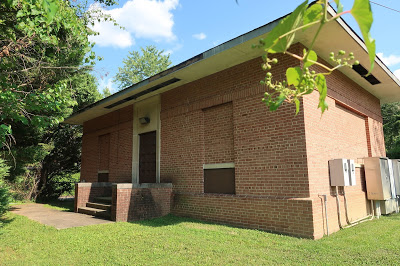 |
| The Holmes Run Pump Station at 6623 Dearborn Drive in the Annandale area. |
Fairfax County is preparing to rehabilitate the Holmes Run wastewater pump station at the corner of Dearborn Drive and Sleepy Hollow Road in Mason District.
Originally built in 1957, the Holmes Run Pump Station (HRPS) is one of the oldest in Fairfax County.
The community is invited to a virtual meeting on the project July 21, 7-8:30 p.m. To participate, visit this link or call +1 (312) 757-3121; access code: 520-217-917.
Work on the current project is expected to start in March or April 2021 and should take 18 months.
Wastewater ends up in Lorton
The HRPS serves a population of approximately 35,000 within a 6.8-square mile area extending to the west and north of the pump station to Arlington Boulevard, the beltway, and I-66, says project manager John Royse in the Fairfax County
Wastewater Design and Construction Division.
The station diverts a portion of the wastewater flow from the 33-inch Holmes Run gravity trunk sewer, which is just south of the pump station, Royse says.
Wastewater is then collected in the HRPS and subsequently pumped via a 20-inch force main pressure sewer to gravity sewer manhole 113, located approximately 2,000 feet north of the pump station on Sleepy Hollow Road.
From there, the wastewater enters the Tripps Run gravity sanitary sewer, is combined with the Holmes Run gravity trunk sewer below Lake Barcroft, and is then eventually treated at Fairfax County’s wastewater treatment plant in Lorton.
Extensive upgrades
Work inside the station includes replacement of the pump and discharge piping system; instrumentation and controls system upgrades; and electrical, architectural, structural, HVAC, and safety improvements.
 |
| The rear of the pump station. |
Exterior improvements include roof replacement and building component rehabilitation, equipment loading system upgrades, a fluid injection system for enhanced odor control, an emergency generator, a surge control tank, a force main bypass pumping connection and access vault, site access and surface stabilization improvements, replacement/rehabilitation of gravity sewer components, and replacement of force main sections.
The rehabilitation has a planning horizon of 30 years, Royse says.
Environmental impacts
After completion, the upgraded HRPS will have several environmental impacts, including construction in a 100-year flood plain, generator noise, and an increase in impervious surface, he says.
To mitigate those impacts, the project will use elevated concrete slab construction with flood vents and flood plain volume offset. A new brick enclosure wall will reduce noise and provide visual screening of the new emergency generator and liquid odor control system.
Some trees and vegetation will be removed in non-buffer areas during construction west of the station where existing sewer pipes need to be replaced and north of the station where access and site improvements are planned. The project is being coordinated with the county’s Urban Forestry office to add trees and shrubs where feasible.
Wastewater will be bypassed during construction using phased temporary bypass pumping installations, Royse says.
Performance requirements for all temporary bypass pumping systems will include protection against a 100-year flood event and multiple pumping units that provide the ability to convey the necessary range of flow up to the required peak flow rate, with a standby pump unit for system redundancy.
In 1995, the pump station underwent a partial rehabilitation, which included the installation of the pump station odor control system, as well as rehabilitation of the ventilation system, channel grinders, minor modifications to the pump discharge piping, modifications to the flow diversion structure, and electrical modifications, Royse says.
More recently upgrades were completed to the building’s electrical and control systems as well as to the on-site flow diversion structure and manholes. The discharge force main was re-lined in 2014.



